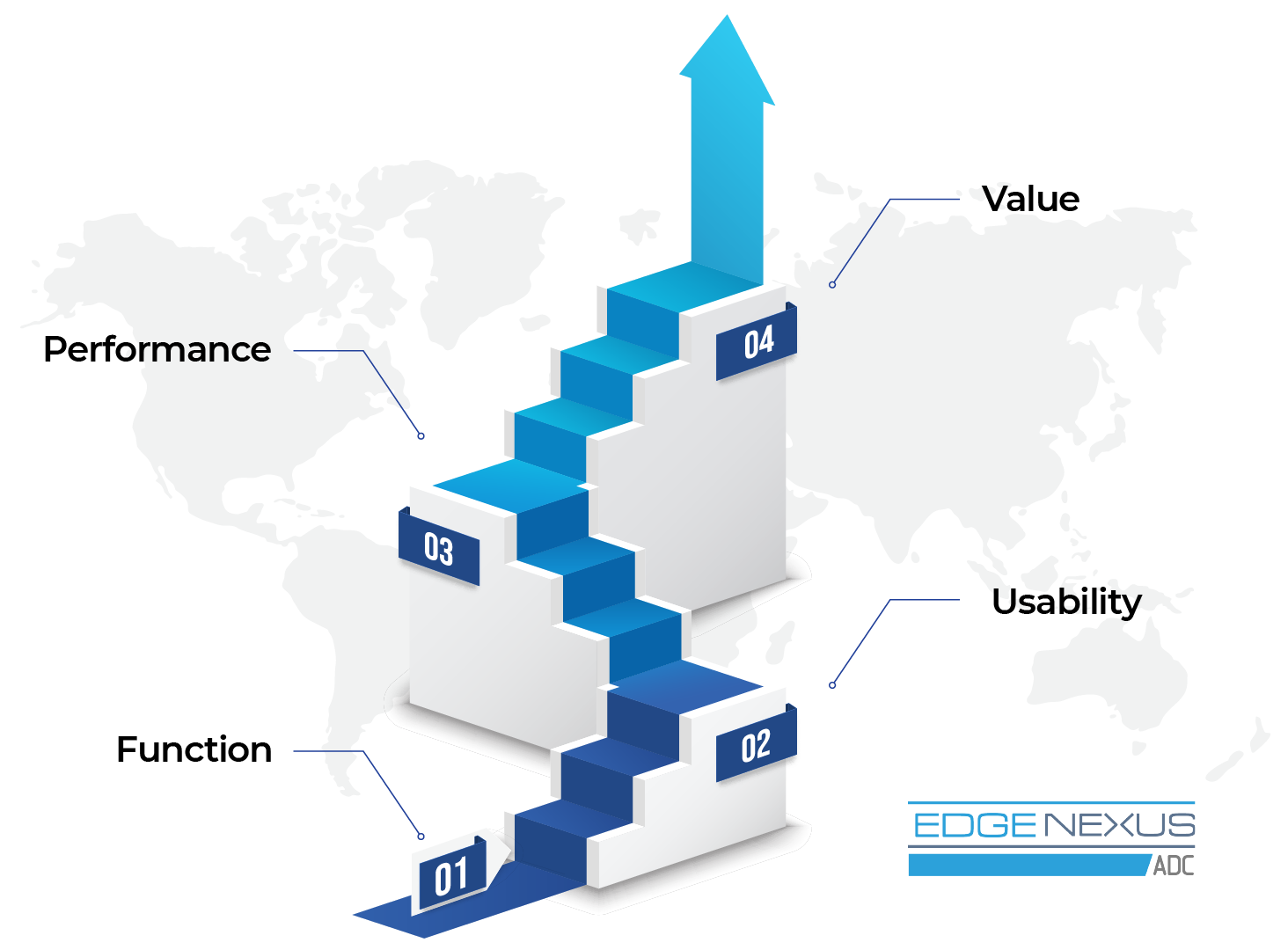- Why Edgenexus?
- Try
- Products
- Solutions
- Applications
- Resources
COMPARE
READ
WATCH
SEE
Alliances and Partners
- Support
Resources
ALLIANCES AND PARTNERS
COMPARE
READ
WATCH
SEE
Alliances and Partners
Resources
ALLIANCES AND PARTNERS
There are many load balancing/ ADC vendors on the market so how do you go about comparing them? What one is best?
The answer as you might expect is not simple and very much depends on your circumstances and requirements. To try and simplify things we will discuss in terms of the categories below that will make comparing load balancers slightly easier.


We still talk a lot about “load balancing” or load balancers but really these devices have evolved significantly and do a lot more than just load balancing. This is the reason why Gartner coined the new term ADC – Application Delivery Controller.
When comparing load balancer we will compare them with respect to ADC functionality as they will all do a great job of basic layer 4 load balancing and its really it’s dying requirement.
It worth noting that some vendors have an “app store” that will allow you to download new functionality and /or apps onto the device.
This is useful especially for software ADC. Unlike a Hardware load balancer a software load balancer can be consistently upgraded and as such has no inherent “shelf life” that dictates at some point it will require a complete load balancer hardware refresh.
These devices have evolved form a complex geeky networking world where you would only be able to configure them after a 2 week course with command line whilst tapping out binary.
The modern usability assessment is more like this:
Usefulness Factor = (Amount of Features Available + Usability) /
(Amount/Time/Cost of Training Required)
For many people managing the ADC is just a small part of their work and as such cant commit the time for drawn out training.
This really ties back into the functionality. Some of the top end devices have all the functionality but the educational investment is so great that it’s wasted.
Whilst this may be ok for the Enterprise where they have the “load balancer/ADC” person it might not work for the mid market where they still may have complex requirements but not necessarily so much dedicated time
So the lesson here is ensure the vendors you are looking at have the feature you require but also ensure its packaged in a useable way.


Many years ago when load balancers were basic layer 4 devices and the next generation of layer 7 ADC devices was emerging this was a massive concern. Layer 7 devices can now deliver outstanding performance.
Many load balancers use the same open source LVS/HAproxy etc code as such they all have a similar performance profile.
This understanding means that they can add value to the transaction from SSL, Caching to more complex traffic management modifying the request and response. Depending on how many of these features you enable you will use significantly more or less CPU.
So most vendors will have a device/software that will cope with your capacity its just choosing the right model. Some will offer a “sizing” tool but these are typically inaccurate as they dont consider the use case. You are much better off having a quick call with the vendor to be sure.
If you are building the next version of google then you should consider vendors such as f5 networks as they have the most scalable solutions else most load balancing vendors offer pretty good performance way more than 99.999 could ever use. Ie Edgenexus can do 40Gbs+ at layer 7.
It is worth noting that most most vendors don’t publish any performance metrics with layer 7 rules in use as these will have a massive effect on performance. It is common that when load balancing a web application some rules such as URL redirect will be used.
So there is Price and Value.
Typically there are 4 components:
However something else that should be considered is flexibility of the licensing.
You may be purchasing these for 3-5 years as such you may be moving from hardware to software or software to cloud. How can the vendor support this? For example can they offer a free licence migration from hard to software?

|
Name
|
Function
|
Usability
|
Performance
|
Value
|
Total
|
|---|---|---|---|---|---|
|
Edgenexus ADC-X
|
😊😊😊😊
|
😊😊😊😊😊
|
😊😊😊😊
|
😊😊😊😊😊
|
18
|
|
f5
|
😊😊😊😊😊
|
😊😊😊
|
😊😊😊😊😊
|
😊😊
|
15
|
|
A10
|
😊😊😊😊
|
😊😊
|
😊😊😊😊
|
😊😊
|
12
|
|
Citrix Netscaler
|
😊😊😊😊
|
😊😊😊
|
😊😊😊😊
|
😊😊😊
|
14
|
We respect all our competitors in this market and the below is our view based on operating in this space for 17 years. Ultimately the best way to decide would be to “Bake of “- download our solution and then compare it to the others.
F5 has been around for a very long time and as such have the largest market share. They are heavily based on hardware for the enterprise and as such struggling to adapt their business to a lower pricing point software ADC market.
There technology is very good although very expensive, complex and in 99.9% of use cases an overkill.
We understand the support to be very expensive and and some customer complain of lock in as they are using features such as i-rules that are difficult to migrate from. In addition the complexity means that many organisations are reliant on a people who have the necessary skills or indeed have to draft in expensive contractor to make changes
F5 can be migrated over to Edgenexus using the automatic edgeSHIELD automation migration facility.
I-rules can be migrated using the free professional services to Edgenexus flightPATH. Check out this blog here to see how i-rules compare to Edgenexus flightPATH.
A10 was set up as a direct competitor to f5 – hence the name. Having settled a patent infringement a10 is now trying to grow their hardware business in the US and european markets.
They seem to be making some process in the large enterprise telco space around 5G especially in Asia. The interface and the usability apparently needs a lot of work and as such they may struggle to gain market share operating in mid market and small enterprise. More telco than application lead approach.
Citrix netscaler load balancer came into the load balancing market by acquisition primarily to support their other products. Many years later this seems to be the main focus. They have recently renamed Citrix netscaler to Citrix ADC. Tends to be pretty expensive.
Citrix netscaler be easily migrated to Edgenexus ADC by simply sending the config files to pre-sales@edgenexus.io. For more complex migrations please contact us and we can look a using the automatic migration tool. Migration consultancy is FREE.
This UK based company has a simple and honest business focus. They take a number of open source packages and install this onto a x86 server (primarily Dell) with their own GUI.
They lack much of the ADC features but are a good solution for layer 4 especially if the organisation has linux experience. In addition they claim to offer great support.
Loadbalancer.org can be easily migrated to Edgenexus ADC by simply send the config files to pre-sales@edgenexus.io In addition existing hardware can be upgraded to run the Edgenexus ADC image. Please contact support and we will send you a bootable ISO image. Please ask sales about any special offers on this upgrade.
All the vendors use different vendor specific language to describe various features. For example f5 I-rules that is the very clever layer-7 traffic manipulation and routing function has a comparable feature with Edgenexus ADC called flightPath.
We will shortly be publishing a detailed technical comparison, however in the mean time please contact us if you would like more detail on how we compare to the load balancers above or even ones that are not listed.
Hardware, software or even your own online image complete with a full test environment.
Just let us know what you need here
People say we are knowledgeable and friendly but you can be the judge of that.
Don’t take our word for it – take a free trial
Request a Free Trial
(Downloaded or cloud provisioned)
APP STORE